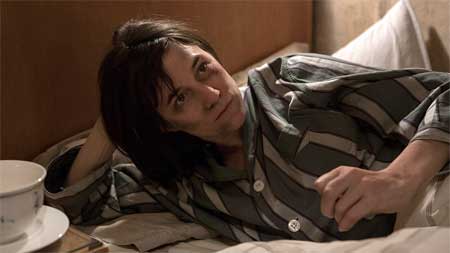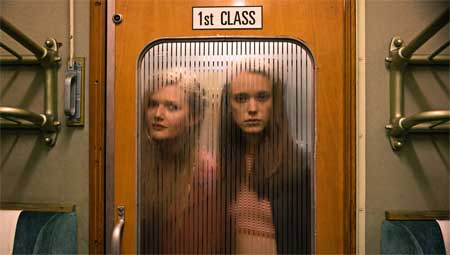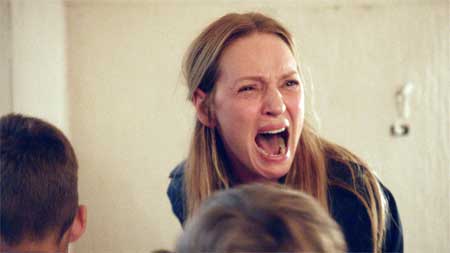Film (2013)
Written and directed by Lars von Trier
Cinematography by Manuel Alberto Claro; Film Editing by Morten Højbjerg, Molly Marlene Stensgaard; Casting By Des Hamilton
With Charlotte Gainsbourg (Joe), Stellan Skarsgård (Seligman), Stacy Martin (Young Joe), Shia LaBeouf (Jerôme), Christian Slater (Joe’s Father), Uma Thurman (Mrs. H), Sophie Kennedy Clark (B), Connie Nielsen (Joe’s Mother), Ronja Rissmann (Joe – 2 Years), Maja Arsovic (Joe – 7 years), Sofie Kasten (B -10 Years), Ananya Berg (Joe – 10 Years), Anders Hove (Odin)

“Grey Lines With Black, Blue and Yellow” (1923)
The Museum of Fine Arts, Houston, TX
Joe (Charlotte Gainsbourg) is discovered, beaten up in the street, by a middle-aged Jewish man named Seligman (Stellan Skarsgård) who brings her into his home for recovery and conversation. As he begins to care for her, the story of her unbelievable early sexual life emerges which, through flashbacks, forms the substance of the film.

in “Nymph()maniac”
Photo: Courtesy of
Magnolia Pictures
For these flashbacks, Stacy Martin (Joe as a young woman) takes over the role. Martin’s portrayal is at once girlish and womanly, oblivious and desperately aware, sensuous and desensitized, expressing throughout a commanding delicacy as a well as a riveting and predatory callousness. It is quite a combination.

in “Nymph()maniac”
Photo: Christian Geisnaes
Courtesy of Magnolia Pictures
To say the least, there is a lot of explicit sex in the film, and not much is held back from view. Martin’s lovely physique certainly gets plenty of air time, and there is a considerable amount of coital and oral interaction that figures in the action. (Interestingly and humorously, in the credits at the end, the film declares something to the effect that no penetrative sex was performed by the major actors and that various body doubles, prostheses and special effects were used to create the extremely realistic seeming illusions.) One montage curiously devotes itself to an almost clinical survey during which one penis after another is displayed in sequence.

Stacy Martin as Joe
in “Nymph()maniac”
Photo: Christian Geisnaes
Courtesy of Magnolia Pictures
Von Trier includes all sorts of sometimes unrelated stuff that adds a curious and unexpectedly whimsical dimension to the constant sexual adventures.
He continues throughout the film to obsess about Fibonacci numbers, and sometimes has animated interludes which show how the sequence of such numbers is developed. When Joe recounts the time she lost her virginity, she recalls vividly it involved three times in the front and five in the back. Three, five and eight, elements of the Fibonacci series, never get forgotten.
There is something curiously Platonic about von Trier’s fascination with number, as though he needs to remind us that the most animalistic part of human nature has a subtle connection with the most ethereally theoretical part. He never wants us to forget that minds are operating everywhere, especially in the bedroom and sometimes in more abstract ways than one would expect. Even desperately obsessive sex has a kind of logic behind it.
There are other unexpected and unsettling things throughout. The film begins with what appears to be an endlessly black empty screen with hints of a soundtrack and this non-scene goes on for several minutes, so long that one begins to wonder whether the whole film will be like that. At some points there is intensely loud and jarring music that appears and disappears. Though these techniques sometimes felt pretentious, they never irritated me enough to draw away from the energy of the film.

in “Nymph()maniac”
Photo: Christian Geisnaes
Courtesy of Magnolia Pictures
And somehow the film, though incredibly sexual, never really feels lurid. It is a fairly long film – almost two hours – but it keeps its energy up. Martin’s magnetism and allure certainly help it to roll along, but there is also something in the narrative itself that is quite gripping. The adventurous sensuality of volume 1 always hovers on the desperation that lies closely behind it. The background shadow of the older, defeated Joe never departs from the scene for long, and the anticipation of what explanatory satisfactions volume 2 might provide is never far off.

in “Nymph()maniac, Volume I”
Photo: Christian Geisnaes
Courtesy of Magnolia Pictures
The cast is an odd and interesting assemblage. In addition to Gainsbourg and Martin, Uma Thurman (Mrs. H) has a fabulous turn as a spurned housewife and mother. The writing and acting of her role are particularly intense and well done. Shia LeBouef (Jerôme) plays a significant love interest and has a kind of earthly, sort of tough guy approach that makes him believably appealing. As well, a bit unexpectedly as Joe’s father, Christian Slater plays an apparently soft and caring type, a bit of interesting casting that portends curiosity in volume II.
Of course, this is just the first part of the saga, and the cliffhanger plot points are fairly interesting and dramatic. I certainly want to see Part 2 to get a sense of what happens to Joe in adulthood, what the story with her father is, how Jerôme might figure into it, and so on.
This is an intense film by an intense director, not so easy to watch, but quite compelling and interesting.

Photo: Courtesy of Magnolia Pictures
It is curious that, in the wake of von Trier’s irresponsibe, and badly received, comments about Hitler and Jews at Cannes a few years ago, he makes a point of creating a deeply sympathetic central character who is Jewish. That character, not surprisingly, given von Trier’s stance, identifies himself as Jewish but not a Zionist. That declaration comes across as odd in the film, but understandable given the significant repercussions of von Trier’s foolish remarks and his apparent need to clarify his stance again. It is a tricky thing to do in the context of a narrative, but given how wacky some of the other stuff is, it does not seem out of place.
Given von Trier’s offensively insensitive and thoughtlessly rambling remarks at Cannes, it might be easy to find the impulse to dismiss this film out of hand, but that, I think, would be a mistake. Though painfully lurid, there is something gripping about the film, and it exhibits the explorations of a filmmaker who operates with a kind of instinctual momentum, not principally governed by thought though drawn to the idea of it, but carried along with a strong sense of wanting to say something significant even if the appropriate words do not easily come.
– Lars von Trier, comments at Cannes 2011 press conference. YouTube, 18 May 2011. Wikipedia
– BADMan
Leave a Reply